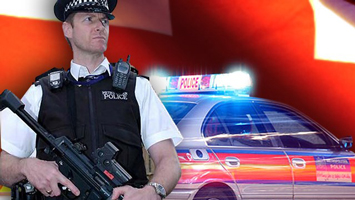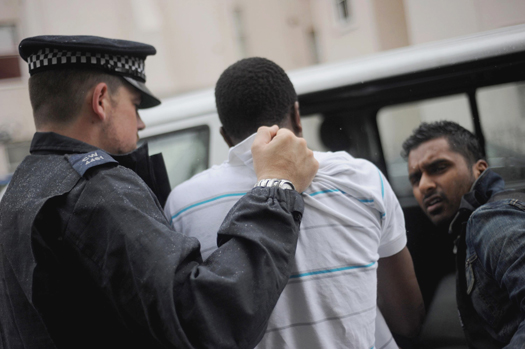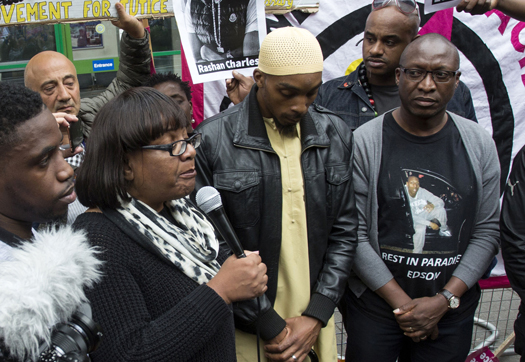The Met’s Violent Arrests of London’s Black Youth Risks Civil Uprising
By Lee Jasper -Guest Columnist- | Last updated: Dec 13, 2017 - 2:51:51 PMWhat's your opinion on this article?

|
No doubt, many will sigh at this point, drop their heads and think, “Here we go again, another gross exaggeration, and yet another anti-police critic, inflating a legitimate arrest into some overblown political bandwagon.”
Of course if you’re Black and fully awake, you will know that history records that all claims of serious racism are always and routinely furiously denied in the first instance. So first of all let’s deal with the objective and broader context of my statement.

|
Using this descriptor “force” will no doubt surprise some but for many of London’s Black communities the Met is no longer perceived as a public service and is increasingly seen by many communities as an aggressive and hostile occupying force.
And today, relations are pretty bad indeed. Earlier this year as a result of a series of freedom of information requests, I discovered that according to annual public confidence survey data supplied to me by the police themselves, in London’s Black communities, trust and confidence in the Metropolitan Police Force, rarely rises above 50 percent, and disturbingly in some of the key areas—such as Lambeth, Newham, Haringey and Hackney—regularly drops to as low as 30 percent.
In terms of violent arrests, the overwhelming picture is that the Met is particularly violent when arresting Black suspects, according to their own figures. Figures published by the Met show that whilst the Black community makes only 13 percent of London’s population, they represent a staggering 36 percent of all police violent arrests in London in a three-month period.

Metropolitan Police officers arrest a suspect, center, after carrying out a raid on a property on the Churchill Gardens estate, in Pimlico, London Aug. 11, 2011 during an operation to recover property stolen during disturbances in the capital. Then British Prime Minister David Cameron said the government is "acting decisively" to restore order after riots that shocked the country. Cameron told lawmakers that "we will not allow a culture of fear to exist on our streets." Photo: AP/Wide World photos
|
This represents around 20,000 violent arrests of Black people every single year and that assumes all violent arrests are reported by police officers, something I personally doubt. There could be many more.
And where the police had to rely on supporting partner agencies, then we often see these agencies themselves infected with racist practices, actively colluding with police violence and racism to mask their own failures.
Such is the case of a 16-year-old London Black college student, and daughter of Mum Joy McIntosh, who on Friday, December 1, was traveling on Bus 149 around 6 p.m. toward Dalston Junction. Let’s call her A.
While on the bus, A was approached by a couple of TfL ticket inspectors. What then followed seemed to be a huge misunderstanding. As a result, TfL ticket inspectors then followed her off the bus and began physically restraining her. A is just 4 ft. 11 inches and weighs around seven stones (98 pounds).
By this time a crowd had gathered, concerned at the apparent treatment of this tiny Black schoolgirl being aggressively manhandled. Increasingly intimidated by a gathering crowd who were appalled at the disproportionately violent treatment of A, the TfL inspectors called for police back up. Meanwhile the crowds became increasing angry and hostile. The inspectors then bizarrely began shouting “stop resisting” as they violently restrained A.
This is, of course, an age-old police tactic of attempting to create a public impression of a suspect resisting arrest or restraint, whilst violently attacking said suspect.
A was then kneed in the stomach by one of the Inspectors and started to cry out for help. As the crowd started to react one of the Inspectors then inexplicably escalated this situation and violently secured A in a headlock–all the time shouting “stop resisting.” A was frightened, terrified and distraught.
The police then arrived and placed her in handcuffs, forcing her hands way up her back.
Throughout the time she was being assaulted by the police officers and TfL inspectors, the crowd were filming and becoming increasingly agitated.
A solitary White woman who witnessed the police violence (Black people, particularly Black men, please take note) tried to intervene. She was violently abused and pushed by a police officer, who then placed A in a headlock and repeatedly punched her. She was subsequently arrested and charged with police assault.
At this point even more people had gathered and A was calling out for someone to call her mother. Someone in the crowd rang and told her mother: “Hello, hello? ... I’ve been asked to ring you urgently, I’m here at Dalston Junction and the police are assaulting your daughter.”
When A’s mother, 36-year-old Joy McIntosh, and her 18-year-old son arrived on the scene, she was confronted with utter chaos. Joy reproved seeing massive angry crowds and tens of police officers, all shouting and milling around.
When Joy, a woman of strong faith, saw her distraught daughter in the back of a police van, she sought to approach and comfort her, but was immediately pushed back by police officers. Joy was then kettled by officers who refused her access to her daughter or her son.
When her son protested at the treatment of his mom, the 18-year-old was pinned to the ground by police and violently arrested, aggravating the crowd even more.
“The level of violence I saw from the police officers at the scene shocked me to the core. It was unbelievable. I was so frightened for his life that although surrounded by police I just kept shouting ‘keep calm, son, stay alive’ repeatedly.”
Both her children were taken to Stoke Newington Police Station, where A says she was denied her rights as a juvenile and subjected to bullying and intimidation by police officers.
She demanded her mother be present as an appropriate adult whilst she was being interviewed, the police refused, and instead brought in a preferred social worker and a local stranger from the boroughs Appropriate Adult Scheme despite her mother being in attendance at Stoke Newington Police station at all times.
A was arrested on Friday evening around 6 p.m. , interviewed around 11 p.m., kept in a cell overnight and finally released on bail on Saturday around 6 p.m. Her brother was released later that day and both were given bail conditions not to stay at their mother’s house and subjected to a nightly curfew from 3 a.m. to 7 p.m. They are both due to return in two-weeks time.
The frequency of these types of incidents, where we see Metropolitan Police Force officers engaged in the violent arrest of London Black folks is increasing.

Member of Parliament, Diane Abbott, left, Ginario Da Costa, right, the father of Edson Da Costa, and Esa Charles, father of Rashan Charles who died after contact with police, arrives at a protest over his death at Stoke Newington police station, London, July 29. Clashes broke out on the streets of east London at that time as riot police tried to disperse protesters, who hurled bottles and fireworks at officers, set garbage cans on fire and barricaded a road. Some held "Black Lives Matter" placards. Photo: AP/Wide World photo
|
Each month thousands of London’s Black communities find themselves experiencing disproportionate violence, when being arrested at the hands of Metropolitan Police Force. It’s just a fact of life, that the Met in particular, are arresting Black youths in such numbers that feelings on the streets today, feels like London, circa 1986.
Met officers seem to have no regard for whether Black suspects are children, young adults or elderly pensioners, the response of too many officers is routinely violent (remember Bristol, St. Paul’s pensioner Ras Judah?). Such incidents have resulted in the police more generally, and the Met in this particular, losing public legitimacy.
The Met, whether that’s tackling criminals or racially profiling Back youth, are viewed with deep suspicion as a direct consequence of their worsening and unacknowledged institutionalised racism. Such public opposition to perceived racist policing is becoming increasingly common in London.
Why was a 16-year-old child subjected to the kind of arrest usually reserved for most serious and dangerous criminals,for nothing more serious than failing to be in possession of an Oyster card that entitles all London 16-year-olds in study, to free travel anyway?
The fact is that both TfL Inspectors and Met Police unnecessary use of violence unduly provoked and inflamed this situation. Given the public interest, and in the interests of good community relations, all charges against A, her brother and the brave woman who sought to intervene should be dropped immediately.
Still questions remain. For example, why was A’s mother denied access to her 16-year-old daughter whilst at Stoke Newington police station? Why was it thought necessary to hold a 16-year-old child for 24 hours for such a minor offense? I have long raised the issue of the undue detention of Black children by the Metropolitan Police Force.
Huge changes to London’s bail system is resulting in far too many young, vulnerable suspects, being unduly detained for long periods of time. As Black public support for the Metropolitan Police Force wanes, the potential for relatively minor incidents to spark widespread civil uprisings rises.
Across London, consistent anecdotal evidence is emerging that Black parents and adults are being denied the opportunity to act as an appropriate adult when in attendance at London’s police stations and that Black children are being held for excessively long periods of time. In the current context, the violent arrest of children could be the spark that ignites wider opposition to perceived police racism.
In terms of a police response to the culture of racism within the Met, any credible response must respond to the Lammy Review challenge of “explain or change.” We’ve seen none of that. What we have seen, however, is increasingly desperate attempts by the Met to justify the unjustifiable, quoting knife and violent crime as their operational rationale for their obvious racism. Except it isn’t and as most informed observers know, there is no relationship between the incidence of violence and rates of stop and search.
The list includes disproportionate stop and search; disproportionate violence; disproportionate arrests; disproportionate refusal of bail; disproportionate charging for like-for-like offenses when compared with White suspects with worse or similar previous antecedents; disproportionate deaths in police custody; disproportionate number of Met Black officers subject to disciplinary investigations by their fellow officers.
Since the trauma of this incident Joy has been inundated with support of the wider community. Tensions are high in the wake of the notorious incidents including Sarah Reed, Edson Da Costa, Rashan Charles and what appears to be the savage beating by police of another 15-year-old, Terrell Decosta Jones-Burton.
I could go on but you get the picture. London is experiencing a resurgence of institutionalized racism within the Metropolitan Police force. This important, but as yet largely unrecognized, fact is clearly discernible from these discreditable and undisputed figures detailing significant disproportionality in all significant aspects of policing.
This situation as it stands today is that Black Londoners are no longer prepared to give the Met police the benefit of doubt when judging the appropriateness of police interventions involving Black people. The reason this relatively minor incident provoked such a strong reaction is because very few Black people or indeed ordinary Londoners, now trust the police to do the right thing where Black people are concerned. In this context even a legitimate police intervention could lead to widespread disorder as a result.
The mayor of London has to reign in the Metropolitan Police Force; he has to get a grip with the real reality he faces, a level of resurgent institutional racism that has become re-energized as a direct result of the abandonment of the recommendations outlined within the McPherson report on the racist murder of Stephen Lawrence.
Only by doing so can he hope to avoid an almost inevitable backlash from a London Black community that feels itself under siege from a hostile, aggressive and all-powerful Metropolitan Police Force.
Lee Jasper is a longtime UK-based activist with 30 years of experience as a leading campaigner for social justice and racial equality and was a Senior Policy Director for Equalities & Policing in London. He has established a range of leading anti-racist organizations. Read more of his writings on leejasper.blogspot.com.
INSIDE STORIES AND REVIEWS
-
-
About Harriett ... and the Negro Hollywood Road Show
By Rabiah Muhammad, Guest Columnist » Full Story -
Skepticism greets Jay-Z, NFL talk of inspiring change
By Bryan 18X Crawford and Richard B. Muhammad The Final Call Newspaper @TheFinalCall » Full Story -
The painful problem of Black girls and suicide
By Charlene Muhammad -National Correspondent- » Full Story -
Exploitation of Innocence - Report: Perceptions, policies hurting Black girls
By Charlene Muhammad -National Correspondent- » Full Story -
Big Ballin: Big ideas fuel a father’s Big Baller Brand and brash business sense
By Bryan Crawford -Contributing Writer- » Full Story






 Click Here Stay Connected!
Click Here Stay Connected!








